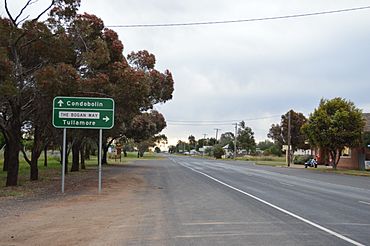Bogan Gate facts for kids
Quick facts for kids Bogan GateNew South Wales |
|||||||||
|---|---|---|---|---|---|---|---|---|---|

Main street of Bogan Gate
|
|||||||||
| Population | 269 (2021 census) | ||||||||
| Postcode(s) | 2876 | ||||||||
| Elevation | 235 m (771 ft) | ||||||||
| Location |
|
||||||||
| LGA(s) | Parkes Shire | ||||||||
| State electorate(s) | Orange | ||||||||
| Federal Division(s) | Calare | ||||||||
|
|||||||||
Bogan Gate is a small village in the Parkes Shire area of New South Wales, Australia. It is located in the Central West region. In 2011, about 307 people lived in Bogan Gate and the surrounding areas. The name Bogan Gate comes from a local Aboriginal word. It means "the birthplace of an important leader of the local tribe."
This village is in an area known for growing wheat and raising sheep. It is also on the main rail line that connects Sydney to Broken Hill. Bogan Gate is also where another rail line, the Bogan Gate–Tottenham Branch line, begins.
If you visit, you can enjoy the yearly Bogan Gate Arts Festival. There are also golf tournaments at the local nine-hole Bogan Gate Golf Club.
Contents
History of Bogan Gate
Early Days
The explorer John Oxley traveled through this area in 1817. The name Bogan Gate first appeared in official government records in 1876. Mail delivery services to Bogan Gate were first advertised in May 1877. The Bogan Gate Post Office officially opened on December 15, 1896.
The arrival of the railway in the late 1800s changed Bogan Gate a lot. It also helped farming in the region. The main railway line from Sydney reached nearby Parkes and Forbes in 1893. When the railway arrived in Bogan Gate in 1896, the village moved south to be closer to the new railway station. Land for the town was measured in 1897, and a public school was built the next year. The railway station became the busiest part of the community. It was especially busy during sheep shearing and harvest times.
The railway made it possible for farmers to grow wheat to sell. Before the railway, it cost too much to transport crops from western New South Wales. Another important change was share farming, which started in New South Wales in 1893. This method helped more people grow wheat.
Growing Up
The town grew quickly after the railway station opened. By 1903, Bogan Gate had a public school with 67 students. It also had a police station, a post office, and a sawmill. There was a general store, a butcher, a baker, and a blacksmith. The town also had two hotels: the Bogan Gate Hotel (built in 1899) and the Railway Hotel.
Bogan Gate had about 300 people when the Shire of Goobang was formed in 1906. By the 1920s, the town had a general store that employed 11 people. There were also stock and station agencies (businesses that help farmers buy and sell animals and land). The town also had a bank, a doctor's office, and another hotel. During the Great Depression, many people had to move to bigger towns to find work.
During World War II, a special site was set up near Bogan Gate. It was used by the Australian Army and Royal Australian Air Force to store important supplies for many years. As of 2014, this former defense site was being used by several different companies.
Bogan Gate Today
Today, Bogan Gate has a public hall, a school, a Post Office, and a hotel/motel.
For fun, residents and visitors can go to Burrawang Park. There is also a nine-hole golf course and tennis courts that are lit up at night.
A festival was held in the town in July 2019, which included fun competitions.
People from Bogan Gate
Some notable people have come from Bogan Gate:
- William Keast (1872−1938), a politician.
- Lu Rees (1901−1983), a bookseller and book collector.
- Jim Taylor (1920−2005), another politician.
- Ian Walsh (1933−2013), a rugby league player.
Gallery

















